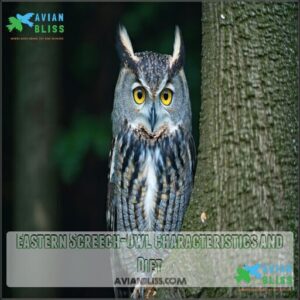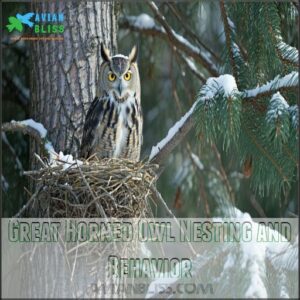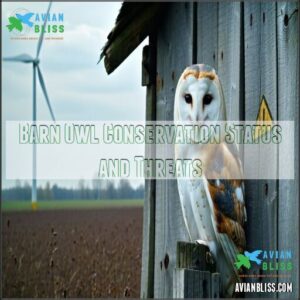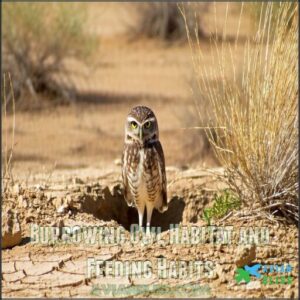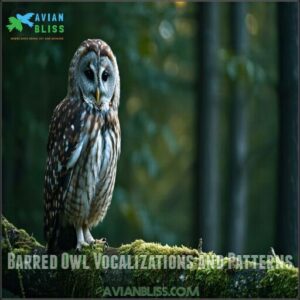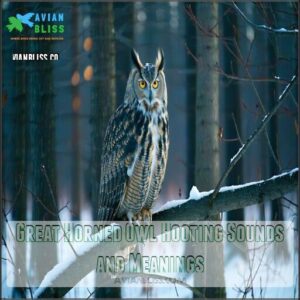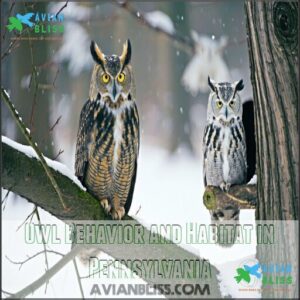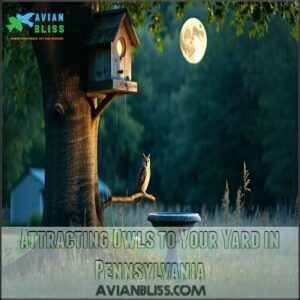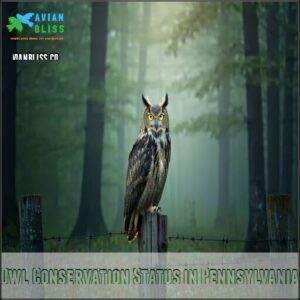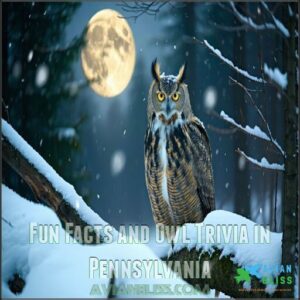This site is supported by our readers. We may earn a commission, at no cost to you, if you purchase through links.
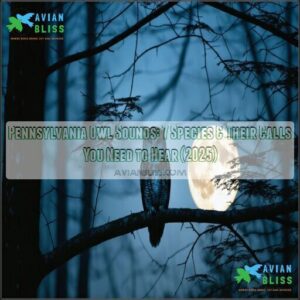
You might also hear the deep, haunting calls of the Great Horned Owl or the spine-chilling screeches of the Barn Owl. Each species has its own unique vocalizations.
Some use their calls for marking territory, while others are chatting up mates or warning off predators. If you’re lucky, a moonlit stroll might reveal their hidden symphony.
Want to identify who’s hooting in your backyard? Pay attention to those rhythms—each one tells a story worth learning, and understanding these sounds can help you connect with the natural world.
Table Of Contents
- Key Takeaways
- Common Owl Species in Pennsylvania
- Identifying Owl Calls in Pennsylvania
- Owl Sounds and Their Meanings
- Owl Behavior and Habitat in Pennsylvania
- Attracting Owls to Your Yard in Pennsylvania
- Owl Conservation Status in Pennsylvania
- Fun Facts and Owl Trivia in Pennsylvania
- Frequently Asked Questions (FAQs)
- What sound does an owl make?
- Why do owls make noise at night?
- What does an owl sound like audio?
- What bird sounds like an owl?
- What is the most common owl in Pennsylvania?
- What kind of owl hoots three times?
- What are the different types of owl sounds?
- What are the six sounds of an owl?
- What does it mean when you hear an owl outside your house?
- What does it mean when an owl is hooting outside your house?
- Conclusion
Key Takeaways
- You’ll hear diverse owl calls in Pennsylvania, like the Barred Owl’s “Who cooks for you?” and the Eastern Screech-Owl’s eerie whinny, each serving distinct purposes like mating or marking territory.
- Nighttime is prime for owls to communicate, with their hoots, screeches, and trills creating a unique nocturnal soundscape that reveals their behaviors.
- Creating owl-friendly spaces with native trees, water sources, and nesting boxes can attract these fascinating birds to your yard.
- Habitat loss, climate change, and pesticide use are major threats to Pennsylvania’s owl population, highlighting the urgency of supporting conservation efforts.
Common Owl Species in Pennsylvania
You’ll find seven distinct owl species in Pennsylvania’s diverse habitats, from the barred owl’s deep "who cooks for you" calls in dense forests to the barn owl’s eerie screeches in open farmlands.
Barred owls serenade Pennsylvania’s forests with their iconic "who cooks for you" calls, while barn owls add mystery with their haunting screeches.
Each species has unique vocalizations and behaviors you can learn to identify, making your nighttime woodland walks more meaningful as you connect with these silent hunters of the dark.
The ability to recognize these species allows for a deeper connection with nature, enhancing the overall experience of exploring Pennsylvania’s diverse habitats.
Barred Owl Description and Habitat
The Barred Owl stands as Pennsylvania’s forest sentinel, instantly recognizable by its chocolate-brown eyes and distinctive round face adorned with white horizontal stripes.
A majestic guardian of Pennsylvania’s woodlands, the Barred Owl captivates with its striking features and iconic, haunting calls.
You’ll find these monogamous birds thriving in mature deciduous forests, particularly near water sources. Their famous "Who cooks for you? Who cooks for you all?" call echoes through Pennsylvania’s woodlands, especially at dusk and dawn.
These remarkable night hunters maintain a hunting radius of about 6 miles from their nests, showing impressive Urban Adaptability as forests fragment.
Here’s what makes Barred Owls fascinating:
- Forest Preference: Favors old-growth forests with tall trees for nesting
- Hunting Habits: Primarily nocturnal, preying on rodents and amphibians
- Vocalizations: Produces over 13 distinct owl sounds and calls
- Territorial Range: Defends roughly 700 acres per pair
- Nesting Behavior: Uses tree cavities or abandoned hawk nests
Eastern Screech-Owl Characteristics and Diet
The Eastern screech-owl comes in two distinct color morphs—gray and reddish-brown—helping these small but mighty predators blend perfectly with Pennsylvania’s woodland backdrop.
Standing just 8-10 inches tall, they pack impressive hunting prowess into their compact frames. Their diet primarily consists of insects, small rodents, and occasionally songbirds, which they capture with silent precision during twilight hours.
- Despite their small size, these territorial owls fiercely defend their home ranges with distinctive whinny-like vocalizations that echo through Pennsylvania forests.
You’ll recognize their trembling calls—somewhere between a horse’s whinny and a ghostly wail—especially during breeding season when territorial displays intensify. They are known for their small size, but also for being mighty predators that blend into the woodland backdrop with their distinct color morphs.
Great Horned Owl Nesting and Behavior
While Eastern Screech-Owls impress with their varied diet, the Great Horned Owl dominates Pennsylvania’s forests with remarkable nesting behavior and territorial prowess.
The Great Horned Owl displays practical resourcefulness during nesting season, preferring to commandeer abandoned hawk or crow nests rather than building their own.
You’ll find these powerful hunters establishing territory in January, when their distinctive "hoo-hoo-hoooooo" calls echo through winter woods.
| Nesting Habit | Behavior Detail |
|---|---|
| Nest Selection | Reuses nests from other species |
| Parental Care | Both parents defend territory fiercely |
| Hunting Strategy | Silent flight with 28-pound talon force |
| Juvenile Dispersal | Young owls leave at 9-12 weeks old |
Their ultra-soft plumage allows for completely silent flight when hunting prey, while their synchronized calling between mates strengthens pair bonds during territory defense.
You’ll recognize them by their prominent "ear" tufts and yellow eyes that seem to pierce the darkness.
Barn Owl Conservation Status and Threats
While Great Horned Owls dominate forests with their powerful presence, Pennsylvania’s Barn Owls face a much different reality.
These heart-faced hunters now hold vulnerable status in Pennsylvania and surrounding states, just one step away from threatened classification.
Barn Owl populations have plummeted since the 1980s due to three primary challenges:
- Habitat loss – Disappearing grasslands and old barns eliminate essential hunting grounds and nesting sites
- Rodenticides impact – Agricultural pesticides poison their prey, causing secondary toxicity in owls
- Climate effects – Changing weather patterns disrupt breeding cycles and reduce prey availability
You’ll find various owl conservation efforts underway, including the Barn Owl Conservation Initiative launched in 2005.
Nest box programs by groups like the Moraine Preservation Fund provide alternative homes, while landowner education helps protect remaining populations.
Even small changes in farming practices can help these ghostly hunters recover from their decline.
Burrowing Owl Habitat and Feeding Habits
While barn owls face significant threats, the burrowing owl takes a completely different approach to life.
Unlike their Pennsylvania cousins, these unusual birds make their homes underground in abandoned mammal burrows.
You’ll find burrowing owls in open, dry areas with sparse vegetation, contrasting sharply with typical Pennsylvania owl habitats.
Their diet shifts seasonally – summer brings insects while winter means small mammals and reptiles.
Most surprisingly, these owls hunt during daylight hours, breaking the nocturnal pattern of their relatives.
Listen for their distinctive "coo-coooo" calls around dawn and dusk.
| Burrowing Owl Traits | Habitat Impact | Conservation Status |
|---|---|---|
| Diurnal hunting | Requires open land | Protected species |
| Ground dwelling | Vulnerable to development | Population declining |
| Colony nesting | Depends on burrowing mammals | Habitat loss threatens |
| Insect/rodent diet | Indicator of prey abundance | Needs conservation efforts |
| Small size (7.5-9.8") | Limits defense capabilities | Monitoring programs active |
Other Owl Species Found in Pennsylvania
While Pennsylvania hosts several familiar owl species, four less common residents bring their own unique sounds to our forests and fields.
These fascinating birds complete the state’s diverse owl population:
- Long-eared Owls: Form winter roosts of 6-50 birds in dense evergreens, with populations declining 91% since 1970
- Snowy Owl winters: These Arctic visitors grace Pennsylvania from November through April, recognizable by their heavy 3-5 pound frames
- Northern Saw-whet migration: Our smallest owl at just 8 inches, they move through the southwest before wintering statewide
- Short-eared hunting: Watch for their distinctive bat-like flight at dusk as they hunt over open grasslands
You’ll rarely spot these elusive creatures, but their calls add rich diversity to Pennsylvania’s nocturnal soundscape.
Identifying Owl Calls in Pennsylvania
You’ll learn to distinguish Pennsylvania’s owl calls by their unique patterns, from the Barred Owl’s famous "who cooks for you" to the Eastern Screech-Owl’s eerie whinny that might make you think a tiny ghost horse is wandering through your backyard.
Each species’ distinctive vocalization serves as a natural fingerprint, helping you identify these mysterious nocturnal residents even when they remain hidden in the darkness of Pennsylvania’s forests, with their calls being a key factor in distinguish Pennsylvania’s owl calls and understanding the natural fingerprint of each species.
Barred Owl Vocalizations and Patterns
After encountering Pennsylvania’s common owl species during woodland walks, you’ll want to recognize their distinct calls.
Barred owls produce the forest’s most recognizable vocalization with their rhythmic "**Who cooks for you?
**" call pattern.
This distinctive owl sound carries up to half a mile through dense woodlands.
The barred owl’s vocal repertoire includes eight different call types, ranging from deep hoots to elaborate duet singing between mated pairs.
Their owl vocalizations typically fall between 400-1200 Hz frequency range, with subtle regional dialects emerging in different parts of Pennsylvania.
When identifying owl calls at night, listen for the barred owl’s consistent phrase length and cadence—it’s like nature’s most reliable nighttime broadcaster.
The barred owl’s vocalizations are key to understanding their behavior, and recognizing their calls can enhance your woodland walking experience, allowing you to better appreciate these common owl species and their distinct calls in their natural habitat.
Eastern Screech-Owl Whinny and Trill Calls
While Barred Owls announce themselves with hooting questions, the Eastern Screech-Owl communicates through surprisingly musical sounds across Pennsylvania’s woodlands. Despite its name, this small owl rarely screeches at all!
The Eastern Screech-Owl’s call variations include:
- A descending whinny that sends shivers down your spine on dark nights
- Soft, monotonic trills that make your heart warm knowing families are communicating
- Sharp, warning barks that instantly alert you to nearby danger
- Gentle purrs that remind you of peaceful domestic contentment
Males typically produce lower pitch differences than females. Their vibrato mastery includes whistles for kin communication, quite unlike their Western screech cousins who sound more like bouncing balls. The Eastern Screech-Owl’s unique vocalizations are a key part of its identity, making it a fascinating species to study and communicate with through its musical sounds.
Great Horned Owl Hooting Sounds and Meanings
While Eastern Screech-Owls charm with their whinnies, the Great Horned Owl commands attention with powerful, resonant hoots that carry up to a mile through Pennsylvania’s forests.
You’ll instantly recognize their distinctive "hoo-h’HOO-hoo-hoo" call—often compared to a foghorn in the night.
Males produce deeper hooting variations while females respond with slightly higher-pitched owl vocalizations. Great Horned Owls often engage in nest takeover behavior, utilizing existing nests from other large birds.
These aren’t just random owl sounds—they’re sophisticated territory defense signals that strengthen pair bonds throughout Pennsylvania’s woodlands. The distinctive call of the Great Horned Owl is a key part of their communication, and their pair bonding behaviors are crucial to their social structure.
Barn Owl Screeching Calls and Warning Signs
While Great Horned Owls announce their presence with deep hoots, the Barn Owl’s communication takes a dramatically different turn.
Those spine-tingling screeches echoing through Pennsylvania nights aren’t from horror movies—they’re Barn Owl vocalizations with specific meanings:
- Territorial screams: Their signature 2-3 second raspy shriek warns others to keep their distance
- Distress signals: When threatened, they emit intense hissing as a predator deterrent
- Family bonds: Soft chirps help parents communicate with owlets
- Acoustic ranging: Quick, staccato clicks aid in spatial awareness during night hunts
You’ll soon recognize these eerie owl sounds as nature’s midnight conversation rather than something spooky!
Burrowing Owl High-Pitched Calls and Mating Habits
The distinctive sounds of Burrowing Owls make these rare Pennsylvania visitors worth seeking out.
These ground-dwelling birds communicate through unique high-pitched calls that serve multiple purposes.
When listening for Burrowing Owl calls, note:
- The male’s hollow "coo-coooo" song that varies with his excitement level
- Raspy "chack" or "cheh" notes males produce during territorial displays
- Females’ down-slurred notes or warbles during pair bonding
- Young owls’ distinctive "eep" calls and rasping sounds
During mating season, males perform elaborate courtship displays.
They’ll hover 5-10 seconds in flight, bow forward to showcase their white throat patches, and offer food gifts to potential mates.
While mostly monogamous, some males maintain two mates simultaneously.
Their communication combines vocal and visual signals, making them fascinating subjects for birdwatchers.
Owl Sounds and Their Meanings
You’ll discover that each owl sound carries specific meaning, from the Barred Owl’s "who-cooks-for-you" territorial call to the Eastern Screech-Owl’s trembling whinny that signals nearby danger.
When you learn to interpret these distinct vocalizations, you’ll transform your nighttime woodland walks into rich conversations with Pennsylvania’s nocturnal residents.
Hooting Sounds and Their Significance
The nighttime symphony of Pennsylvania owl sounds carries specific purposes beyond mere noise-making.
When you hear the deep, resonant hooting of a Great Horned Owl, you’re witnessing acoustic ecology in action—it’s establishing territory and warning others to keep their distance.
Each species displays remarkable variation in their vocalizations; Barred Owls’ famous "who cooks for you?" calls primarily strengthen family bonds, while Eastern Screech-Owls use soft trills during courtship.
Sound spectrograms reveal how these calls evolved unique patterns that travel effectively through forest environments.
Next time you’re outdoors after dark, listen carefully to the owl hooting sounds—you’ll recognize these messages aren’t random, but purposeful communication serving social, territorial, and survival functions.
Whinny Calls and Territorial Defense
While hooting calls may get most of the attention, the distinctive whinny of the Eastern Screech-Owl serves a vital purpose in Pennsylvania’s forests.
When you hear this descending, tremolo-like whistle that resembles a horse’s soft neigh, you’re witnessing active territorial defense in action.
The whinny call functions primarily as an acoustic boundary marker, with each owl using unique whinny variations to declare ownership of their hunting grounds.
These vocalizations typically intensify during breeding season as owls become more protective of nesting sites.
- Male screech-owls produce deeper, more resonant whinnies compared to females’ higher-pitched versions
- A single whinny sequence lasts 2-3 seconds, dropping in pitch throughout
- These calls carry effectively through dense Pennsylvania woodlands, reaching other owls up to half a mile away
You’ll hear this distinctive owl territoriality display most frequently at dusk and dawn.
Screeching Calls and Warning Signs
Amid the darkness of Pennsylvania’s forests, owl screeches serve as nature’s alarm system.
When you hear a Barn Owl’s blood-curdling screech, you’re witnessing its distress call—a powerful warning to others about lurking predators.
The Eastern Screech-Owl employs similar territorial screeches but with its distinctive descending whinny when sensing danger.
These owl vocalizations aren’t random; they’re sophisticated predator warnings that vary in intensity based on threat levels.
Barn Owl alarms often sound most piercing when protecting nests, while owl territoriality displays include specific screech patterns to ward off intruders.
Learning to identify these owl sounds helps you understand what’s happening in the nocturnal world around you, and recognize the importance of predator warnings and territorial screeches.
Trill Calls and Mating Habits
While screeching calls serve as warnings, trill calls play a completely different role in owl communication.
Trills function as the romantic language of owls, particularly during mating season in Pennsylvania.
Eastern Screech-Owls are masters of these melodic vocalizations, with males performing elaborate trill patterns to attract females.
When successful, pairs engage in synchronized vocal duets that strengthen their bond before nesting begins.
You’ll hear these courtship rituals throughout Pennsylvania forests from late winter through early spring, especially on calm, clear nights.
- Males use varying pitch and rhythm in their trills for mate selection
- Females respond with softer trills, creating intimate vocal duets
- Established pairs maintain territory defense through coordinated trilling
- Trill patterns become more frequent and complex during peak owl mating seasons
Other Owl Sounds and Their Meanings
Beyond the familiar hooting patterns, Pennsylvania’s forests harbor a rich tapestry of owl vocalizations that tell stories of survival and community.
While mating trills captivate listeners, you’ll also encounter distinctive owl sounds across species.
Listen for the Long-eared Owl’s soft, pulsed hoots that signal territorial boundaries. The Northern Saw-whet’s mechanical "too-too-too" might remind you of a squeaky bicycle wheel—these juvenile owl sounds often differ from adult calls.
Distress call variations exist across all species, from the Short-eared Owl’s barking when threatened to the Barn Owl’s blood-curdling scream.
These Pennsylvania owl sounds aren’t just noise—they’re sophisticated communication systems that help these masters of silent flight acoustics navigate their world.
Owl Behavior and Habitat in Pennsylvania
You’ll find Pennsylvania’s seven owl species adapting to diverse habitats, from the Great Horned Owl’s preference for wooded areas near open fields to the Short-eared Owl’s grassland hunting grounds.
Their behaviors vary substantially throughout the seasons, with resident species like the Eastern Screech-Owl maintaining territories year-round while visitors like the Snowy Owl appear only during winter months.
Nocturnal Habits and Hunting Patterns
Pennsylvania owls transform the night into their hunting grounds with remarkable efficiency.
You’ll be amazed by their specialized adaptations for nocturnal success:
- Sensory Adaptations: Asymmetrical ear placement helps triangulate prey sounds with pinpoint accuracy
- Silent Flight: Specialized feather edges eliminate sound, letting them ambush unsuspecting rodents
- Exceptional Vision: Eyes collect available light, allowing them to spot movement in near-darkness
These nocturnal birds of Pennsylvania rely on these hunting techniques for survival, making them perfect predators under moonlight.
Their activity periods typically peak just after sunset and before dawn.
Nesting Sites and Tree Preferences
In the context of nesting, owls in Pennsylvania are like savvy real estate hunters, each with their unique owl habitat preferences.
Barred Owls love hardwood forests, often nesting 20-40 feet high in hollow tree cavities big enough for their family.
Great Horned Owls prefer lofty perches like broken pine or oak tops, soaring up to 70 feet for safety.
Eastern Screech-Owls are fuss-free, claiming lower snags or nesting cavity sizes of 10-30 feet.
Barn Owls prefer old-growth trees near forest edges, blending comfort and functionality.
Long-eared Owls, however, choose dense conifers with neatly branching forks—perfect for avoiding nest site competition.
If you’re in urban areas or have yards, install nesting boxes.
These mimic natural hollows, showing that even modern spaces can support owl habitats PA.
Feeding Habits and Prey Preferences
In regards to what’s on the menu, Pennsylvania’s owls show a fascinating mix of owl diet preferences and hunting techniques. It’s not just about catching prey—it’s about survival in diverse habitats.
- Barred Owls snack on squirrels, chipmunks, and other small mammals scurrying through forest floors.
- Eastern Screech-Owls, tiny but fierce, enjoy insects, frogs, and songbirds.
- Northern Saw-whet Owls prefer a seasonal diet of deer mice, tracking their population rhythms.
What’s amazing? Owls swallow prey whole, coughing up fur-and-bone pellets later. These predator-prey relationships are essential for ecosystem balance. Whether it’s urban diets or woodland feasts, an owl’s predator-prey relationships truly showcase their dietary adaptations and skillful hunting!
Migration Patterns and Seasonal Changes
As winter approaches, Pennsylvania’s owl migration is like a well-rehearsed symphony.
These mysterious birds adapt to seasonal shifts, chasing food and finding safe winter habitats. While some stay put, others set out on journeys influenced by migration triggers like climate and prey availability.
- Great Horned Owls: Permanent residents, calling their territories home year-round.
- Short-eared Owls: Known for seasonal diet changes, they migrate south to hunt in open fields.
- Snowy Owls: Rare visitors with striking plumage, they appear in airports, dunes, and farmlands.
- Northern Saw-whet Owls: Tiny, precise travelers covering miles during migration season.
- Barn Owls: Flexible hunters adjusting movements based on prey and weather conditions.
If you step outside at dusk, you might catch their owl vocalizations—a mix of hoots, screeches, and trills—all hinting at their seasonal survival strategies.
Conservation Efforts and Threats
Shifting seasons remind us that owls face unique challenges. Protecting their habitats isn’t just noble—it’s necessary for biodiversity.
Many species face threats like habitat loss, pesticide exposure, climate impacts, road mortality, and illegal nest destruction, making owl conservation PA a priority.
You can make a difference through simple actions:
- Support Habitat Preservation
Protect forests and fields by backing local owl conservation initiatives. Every tree saved is a potential nest.
- Reduce Pesticides
Fewer chemicals mean healthier rodents and insects—essential owl snacks.
- Volunteer for Owl Conservation Programs
Support nesting projects or report habitat loss.
Owls may not hoot thanks, but their survival speaks volumes about the importance of owl conservation programs.
Attracting Owls to Your Yard in Pennsylvania
If you want owls to visit your yard, creating a habitat that mimics their natural environment is key.
Providing native plants, safe nesting spots, and reliable water sources can help attract these amazing nocturnal hunters.
Planting Native Vegetation and Trees
Creating space for owls begins with Native Trees. Pennsylvania’s owls are more likely to visit if your yard feels like home: full of Habitat Restoration and Vegetation Benefits.
Top Trees for Attracting Owls:
- White Oak: Supports insects and shelters prey.
- Eastern Pine: Keeps owls cozy all year.
- Red Maple: Adds hiding spots and vibrant beauty.
Here’s why these trees matter:
Tree Purpose Benefit
Attract owls by ensuring fresh water sources are available. Listen for those magical Pennsylvania owl sounds.
Providing Food Sources and Water
To draw owls, offer water and attract prey.
Set up a shallow birdbath with clean water—it’s essential for both owls and their prey’s survival. Keep it fresh to prevent algae and mosquitos.
Install bird feeders to lure small birds, a key part of an owl’s diet. Position feeders near shrubs (protection for birds) but away from dense brush to avoid rodents overrunning your yard.
A proper birdbath depth is important for attracting a variety of birds.
- Pro tip: Pennsylvania owl sounds might grace your yard at dusk—a reward for creating ideal owl hunting habitats!
Creating a Bird-Friendly Environment
To transform your yard into an owl-friendly environment, focus on creating cozy, welcoming spaces.
Use native plants like shrubs and tall trees to provide natural perches and camouflage, essential for owl habitats. Include water sources such as birdbaths, ensuring they’re kept clean and accessible.
Add nesting sites, like tall Owl Houses, to encourage owl nesting. Skip overzealous yard cleaning—fallen leaves and twigs attract small prey, making hunting easier.
A “wild” space feels like home to owls. Consider sourcing local flora to further enhance the natural habitat.
By designing with these elements, you’re not just inviting fascinating visitors; you’re also supporting owl conservation efforts and enjoying the magic of owl attraction in your own backyard.
Avoiding Pesticides and Harmful Chemicals
Owls thrive when you avoid harmful chemicals and embrace pesticide alternatives. Reducing chemicals keeps their prey safe and supports owl conservation.
Try safe gardening practices like companion planting or introducing natural pest controllers, like ladybugs. These steps promote habitat preservation and protect owls from common conservation threats.
Keeping your yard chemical-free creates an owl-friendly environment where wildlife flourishes. Plus, who wouldn’t trade buzzing pests for the soothing calls of owls in their habitat?
Installing Nesting Boxes and Roosting Sites
If you’re hoping to attract Pennsylvania owls to your yard, start by installing correctly designed owl nesting boxes.
Box Placement matters—mount the box 10-15 feet high in a quiet, shaded area near mature trees.
Choose sturdy designs with good drainage, and add Roosting Materials like wood shavings inside to create a cozy space.
To keep predators out, include Predator Guards around the box opening.
For long-term success, schedule regular Box Maintenance by cleaning out old nests annually to prevent pests.
Consider purchasing owl boxes for ideal design.
Thoughtful Site Selection helps create an owl-friendly environment, supporting owl conservation and encouraging sounds of these fascinating birds around your home.
Owl Conservation Status in Pennsylvania
You mightn’t realize it, but owls in Pennsylvania face serious challenges like habitat loss, climate change, and human conflict.
Understanding their conservation status can help you support these fascinating birds and guarantee they remain a key part of the ecosystem.
Threats to Owl Populations and Habitats
Protecting owls in Pennsylvania starts with understanding the biggest challenges they face.
Habitat loss from sprawling cities, shrinking forests, and expanding farms is forcing them out of their homes. Add Climate Change, and their migration and food chains get thrown off balance.
Here’s why things are tough for owls:
- Vehicle Strikes kill during nighttime hunting trips.
- Pesticide Use poisons small mammals, wiping out prey.
- Prey Scarcity makes survival harder.
- Light Pollution disrupts their night vision, making hunting tricky.
- Owl Habitat Loss steals nesting spots.
Tackling these owl conservation threats requires paying attention to these details. Let’s keep Pennsylvania’s night skies filled with these quiet hunters.
Conservation Efforts and Organizations
Habitat preservation and rescue programs are the backbone of owl conservation in Pennsylvania.
Organizations like the Pennsylvania Game Commission work tirelessly to restore forests, combat owl habitat loss, and create owl-friendly environments.
Public education campaigns teach how simple actions—like installing nesting boxes—protect owls.
Policy advocacy guarantees funding initiatives address owl conservation threats.
Here’s a quick overview:
| Effort | Goal | Example |
|---|---|---|
| Habitat Preservation | Safeguard nesting and hunting areas | Reforestation projects |
| Rescue Programs | Aid injured or displaced owls | Creating rehabilitation centers |
| Public Education | Promote awareness | Workshops and school visits |
Every small effort helps owls thrive and contributes to a healthier ecosystem.
Climate Change Impacts on Owl Habitats
Keeping owls thriving in Pennsylvania isn’t getting any easier with climate change stirring the pot.
Rising temperatures and habitat shifts push these birds to unfamiliar lands, where finding food is trickier. Prey availability drops due to disrupted ecosystems, and extreme weather wreaks havoc, damaging nests and raising the stakes for breeding success.
Here’s what’s happening:
- Hunting’s harder with fewer prey.
- Storms destroy nest sites.
- Unstable weather impacts tree cover, key for shelters.
- Displacement increases competition.
Smart conservation strategies can help stabilize owl population trends.
Habitat Loss and Fragmentation
Owls in Pennsylvania face big challenges when their homes are carved up like a pizza missing slices. Owl habitat fragmentation makes it harder for these birds to thrive, and here’s how:
- Urbanization relentlessly cuts forests into smaller, disconnected patches, leaving many owl habitats unusable.
- Forest fragmentation reduces prey availability, forcing owls to expend more energy hunting.
- With fewer tall trees, nesting declines, especially for species needing isolated areas.
- Conservation strategies like wildlife corridors help reconnect fragmented forests, offering hope for survival.
Pennsylvania owls, like the Barred Owl or Eastern Screech-Owl, depend on intact forests to thrive. By addressing deforestation impact, you can help keep their calls echoing through the trees for future generations.
Human-Owl Conflicts and Solutions
Human-owl conflicts often arise, but small changes can keep the peace. To prevent owl predation, secure pets at night and clean up food scraps that attract rodents.
Combat habitat encroachment by preserving natural spaces and blocking chimneys or attics to deter nesting. Vehicle strikes and electrocution risks can’t be ignored—drive cautiously in owl-heavy areas and advocate for wildlife-safe utility designs.
Poisoning threats are another concern; avoid rodenticides that harm Pennsylvania owls indirectly. Burrowing owls also face challenges due to conflict with humans, often related to housing developments.
For persistent owl nuisance issues, consider safe relocation with experts. With thoughtful owl coexistence efforts, Pennsylvania’s owl conservation journey can thrive for everyone’s benefit.
Fun Facts and Owl Trivia in Pennsylvania
You’ll be amazed by the remarkable adaptations and surprising quirks that make Pennsylvania’s owls unique.
From their silent flight to their intriguing calls, these nocturnal birds are packed with fascinating traits worth exploring.
Owl Myths and Legends in Pennsylvania
Stories about owls have a mysterious charm, don’t they? In Pennsylvania, these nocturnal birds often flutter between folklore and superstition.
Owls are seen as more than just birds—they’re symbols, messengers, and even omens in Native legends. Their haunting sounds, like the Barred Owl’s “Who cooks for you?” or the Screech-Owl’s trembling trill, inspire awe and, sometimes, fear.
Many believe these unique owl sounds carry messages from the spiritual world. Some think hearing an owl signals wisdom or guidance, while others see it as a sign of change—or, occasionally, bad luck.
- Cultural Impact: Linked to mystery and fate.
- Superstitions: Owl sounds as warnings.
- Folklore Origins: Spiritual messengers in Native beliefs.
Unique Owl Characteristics and Adaptations
Picture a master hunter blending seamlessly into the Pennsylvania woods. That’s an owl for you, perfectly designed for stealth. Their Camouflage Plumage isn’t just for show—it mimics tree bark, making them nearly invisible during the day. Combine that with their Silent Flight, and owls become nature’s ninjas. Their feathers have a unique Feather Density and serrated edges, absorbing sound as they move.
Now add unmatched Talon Strength. Owls can crush prey with an iron grip, while their hooked beak tears apart their catch effortlessly. Their Head Rotation, which stretches up to 270 degrees, is another marvel of owl morphology, allowing them to track movement without missing a beat.
And then there’s vision: keen eyes so powerful they can spot a mouse in moonlight. Owls also have asymmetrical ear placements which aids in precise sound localization. Every creak, hoot, or screech in the night defines owl vocalizations—a signal of their masterful adaptations.
Owl Intelligence and Problem-Solving
You know what’s fascinating? Owl intelligence isn’t just about catching mice—it’s like nature’s brainpower in action.
Thanks to advanced owl cognition, these birds can problem-solve with impressive precision, tweaking their hunting strategies and storing extra snacks for leaner times.
Their adaptability skills are phenomenal. They adjust to shifting environments using sharp sensory perception, like detecting the faintest rustle in total darkness.
Owl adaptive learning? It’s next level—these birds adapt to new challenges like seasoned pros.
And let’s not forget owl sounds and meanings—they’re not just hooting randomly. Calls can serve as signals, warnings, or even lessons for their kin.
- Spotlight moments in problem-solving mid-hunt.
- Learning behaviors in unpredictable weather.
- Communication secrets in unique calls.
- Survival mastery even in harsh ecosystems.
Owl Social Behavior and Mating Habits
Owls have complex social lives, especially in the context of courtship rituals.
Males impress potential mates with elegant flights and melodic owl sounds, wooing females into lasting pair bonds—many species mate for life.
They also practice cooperative breeding, with food sharing playing a key role in trust-building.
Females select nesting spots while males fiercely enforce territoriality, often resolving owl territorial disputes through vocalizations.
Their synchronized calls aren’t just communication; they’re nature’s symphony.
These behaviors highlight their fascinating strategies, proving that owl mating habits are as enchanting as their hauntingly beautiful hoots at night, showcasing their unique approach to lasting pair bonds.
Interesting Owl Facts and Records
Owls are full of surprises, especially in regards to their unique abilities.
With their stealthy hunting skills and fascinating adaptations, they’re true marvels of nature.
Here are some fun owl facts and records that might leave you wide-eyed:
- 270-degree neck rotation gives them a nearly full panoramic view of their surroundings.
- Talon strength allows them to snatch prey quickly.
- Plumage softness makes silent flight possible.
- Some species are master nest stealers from other birds.
- Their impressive migration distance helps them adapt to seasons seamlessly.
Pennsylvania’s owl sounds reveal incredible behaviors worth exploring!
Frequently Asked Questions (FAQs)
What sound does an owl make?
An owl’s sound depends on its species.
You’ll hear hoots from great horned owls, eerie whinnies from screech-owls, or harsh screeches from barn owls.
Each call serves to communicate, mate, or warn.
Why do owls make noise at night?
Nighttime is the owl’s prime time to chat, hunting for prey or wooing a mate.
Their haunting calls help them mark territory, communicate with partners, and warn off competitors—like nature’s midnight radio DJs.
What does an owl sound like audio?
If you’re curious, owls produce fascinating sounds—ranging from the Barred Owl’s “Who cooks for you?” hoots to the Barn Owl’s sharp screeches.
Each species has distinct calls, often haunting yet mesmerizing in nature.
What bird sounds like an owl?
You might hear a Mourning Dove and mistake it for an owl.
Their soft, mournful cooing sounds strikingly similar to owl calls, but they’re common during the day, unlike owls that are mostly nocturnal.
What is the most common owl in Pennsylvania?
Think of Pennsylvania’s woods as a symphony, and the Great Horned Owl is the first violin.
It’s the state’s most common owl, known for its unmistakable hoots and a fierce, commanding presence.
What kind of owl hoots three times?
The Great Horned Owl often hoots three times in a rhythmic pattern, like "hoo-hoo-hooooo."
This deep, haunting call is their signature sound, helping them communicate and defend territory.
Especially during the quiet of night, this call is crucial for their communication and territorial defense.
What are the different types of owl sounds?
Owls make a variety of sounds: hoots, screeches, trills, whinnies, and even screams.
These calls help them find mates, warn intruders, or communicate with kin.
Each owl species has unique vocalizations, creating nature’s nocturnal soundtrack.
What are the six sounds of an owl?
An owl’s song whispers mystery into the night, ranging from haunting screeches to melodic hoots.
You’ll hear coos, trills, whistles, shrieks, and barks in their calls, each serving to charm mates or defend territory.
What does it mean when you hear an owl outside your house?
Hearing an owl outside your house might symbolize wisdom, change, or intuition in some cultures.
Scientically, it simply means the owl is likely hunting, marking territory, or communicating with a mate nearby.
What does it mean when an owl is hooting outside your house?
It’s like nature’s ringtone!
When you hear an owl hooting, it’s staking territory, attracting a mate, or warning predators.
Their calls, unique and rhythmic, are more about survival than spooky superstitions.
Conclusion
Exploring Pennsylvania owl sounds isn’t just about identifying who’s hooting—it’s a way to connect with nature’s subtle rhythms.
From the Barred Owl’s conversational hoots to the Barn Owl’s hair-raising screeches, each call reveals a fascinating story.
Take time to listen carefully, and you’ll also sharpen your birding skills and deepen your appreciation for these remarkable creatures.
Whether in your backyard or on a moonlit trail, the hidden symphony of owls awaits your discovery.


